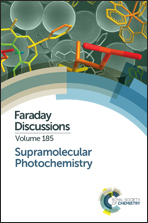Energy transfer within self-assembled cyclic multichromophoric arrays based on orthogonally arranged donor–acceptor building blocks†
Abstract
We herein present the coordination-driven supramolecular synthesis and photophysics of a [4+4] and a [2+2] assembly, built up by alternately collocated donor–acceptor chromophoric building blocks based, respectively, on the boron dipyrromethane (Bodipy) and perylene bisimide dye (PBI). In these multichromophoric scaffolds, the intensely absorbing/emitting dipoles of the Bodipy subunit are, by construction, cyclically arranged at the corners and aligned perpendicular to the plane formed by the closed polygonal chain comprising the PBI units. Steady-state and fs time-resolved spectroscopy reveal the presence of efficient energy transfer from the vertices (Bodipys) to the edges (PBIs) of the polygons. Fast excitation energy hopping – leading to a rapid excited state equilibrium among the low energy perylene-bisimide chromophores – is revealed by fluorescence anisotropy decays. The dynamics of electronic excitation energy hopping between the PBI subunits was approximated on the basis of a theoretical model within the framework of Förster energy transfer theory. All energy-transfer processes are quantitatively describable with Förster theory. The influence of structural deformations and orientational fluctuations of the dipoles in certain kinetic schemes is discussed.
- This article is part of the themed collection: Supramolecular Photochemistry

 Please wait while we load your content...
Please wait while we load your content...